Route of Emperors and Kings – the Danube
The Route of Emperors and Kings
The Route of Emperors and Kings is an epic road trip along the Danube from Regensburg in Bavaria to Budapest, through scenic landscapes, local attractions and historical sites. If you’re driving, it doesn’t get much better than the Passau to Vienna section; at 284 kilometres it’s tailor-made for a long weekend road trip and if time is on your side you can always ease back on the throttle and make a longer holiday out of it.This route has it all, from baroque monasteries and palaces, medieval castles and ruins, to pretty towns that carry the weight of history. The driving connoisseur exits the Autobahn and enjoys the pure driving pleasure of country roads beside the Danube.
It goes without saying, but any wine stops detailed on this page are for the benefit of hire car passengers ... designated drivers must confine themselves to drinking in the scenery.
Book a rental car today and explore Germany
The town on three rivers: Passau
Before you leave town take time to stretch your legs and enjoy a relaxed stroll through the magical winding lanes of Passau’s old town. From the centre of the historic old town the three towers of St. Stephan’s cathedral rise majestically and, once inside, look for the largest cathedral organ in the world. The sumptuous baroque interior of the cathedral has a vast array of ornaments, stucco, frescoes and sculptures and is extremely impressive.Another must-visit ensemble towers above Passau and the three rivers: Fortress Oberhaus is one of the biggest preserved fortified castles in Europe.
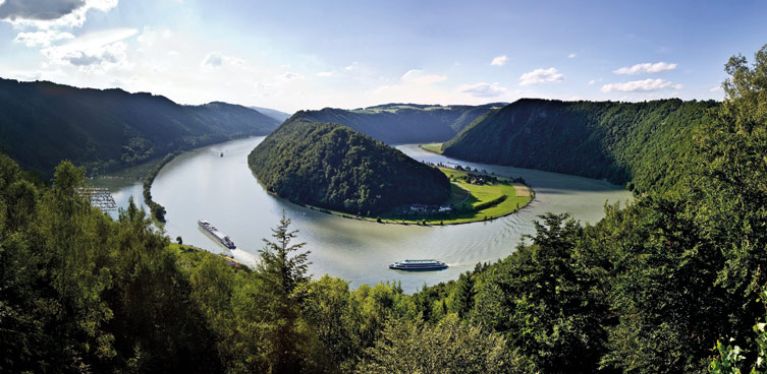
Nature at work: Change of direction at Schlögen bend on the Danube
This unique natural landmark which causes the Danube to make two spectacular changes of direction is around halfway between Passau and Linz.A pit stop is in order, with a front-row seat on the terrace of the Hotel & Restaurant Donauschlinge, with one eye admiring the amazing scenery of the Danube and the other on the Austrian delicacies on the plate in front of you.
City Life: Linz — historic Danube city with a hip cultural scene
Linz is two worlds in one city. The architecture is a mix of traditional and modern, it feels cosy and traditional but also has a hip cultural scene.A short walk from the baroque main square, where they serve classic Linz Torte in the cafés, you encounter ultra-modern architecture like the Lentos Art Museum with a prestigious collection of modern art, and the Ars Electronica Center, with its futuristic design resembling a Danube barge.
The Forum Metall exhibition integrates the city’s industrial side into this mix, with hefty abstract steel sculptures set on the river bank in the Donaupark.
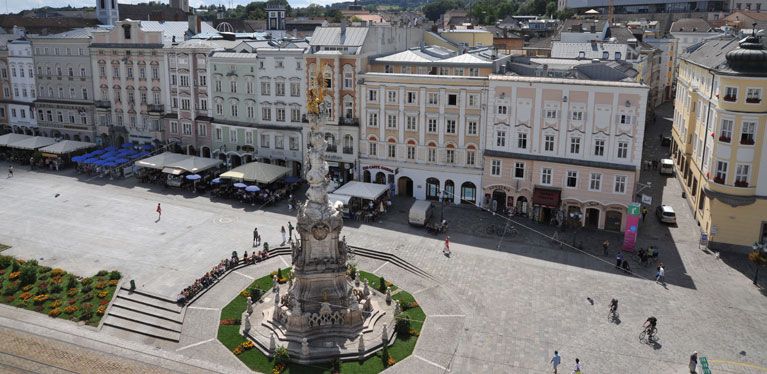
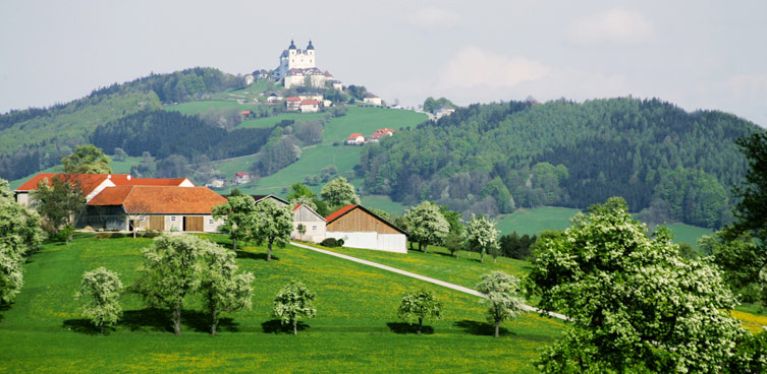
Where enjoyment is unavoidable: Mostviertel region
Enjoy the Mostviertel with its quiet, gently-undulating landscape. Connoisseurs rave about the pear wines and classy distilled fruit spirits from the region, the only place in Europe with strict varietal purity. Places to taste and purchase these local delicacies are the Mostbirnhaus in the Stift Ardagger monastery dating from 1049 and the Mostelleria operated by Josef Farthofer in Oed-Öhling.Farthofer is a 5th-generation distiller of top-quality fruit spirits and uses the traditional schnapps method. His “Mostello” product is a unique concoction, a dessert wine which mixes pear wine with distilled pear spirit and in the tradition of port, is then matured in oak casks. A well as the impressive tasting room, cellar tours are also available at the Mostelleria.
Romance is in the air: Schloss Artstetten
Schloss Artstetten is set in the middle of the enchanting castle park and at one time was the family seat and summer residence of the Imperial family. The castle contains a museum dedicated to Archduke Franz Ferdinand; a walk through the castle grounds to enjoy the fresh air is well worth it, the park is considered one of the most important historical parks in the country.Cultural highlight: The Benedictine abbey of Melk – a baroque jewel on the banks of the Danube
In the aftermath of Austria’s defeat of the Turks in 1683 the Austrian monarchy became the undisputed rulers of the Danube. This triumphant victory was celebrated in the exuberant Danube baroque style which began to appear in churches and monasteries along the river.Abbeys such as St. Florian or Klosterneuburg are an impressive validation of the former secular and religious power wielded by the Habsburgs. Stift Melk is opulence personified and you are sure to marvel at the beauty of the church and its grounds.
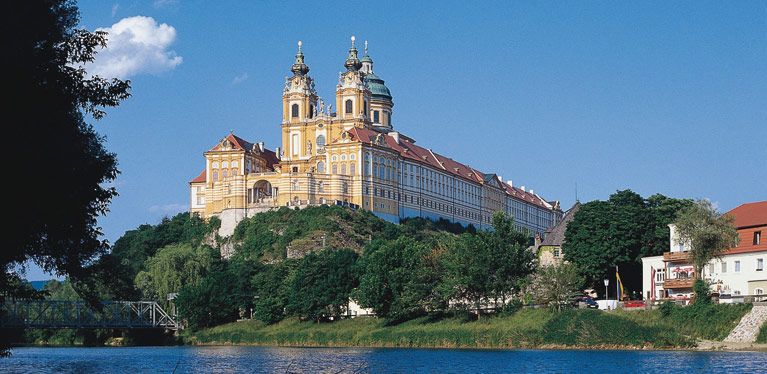
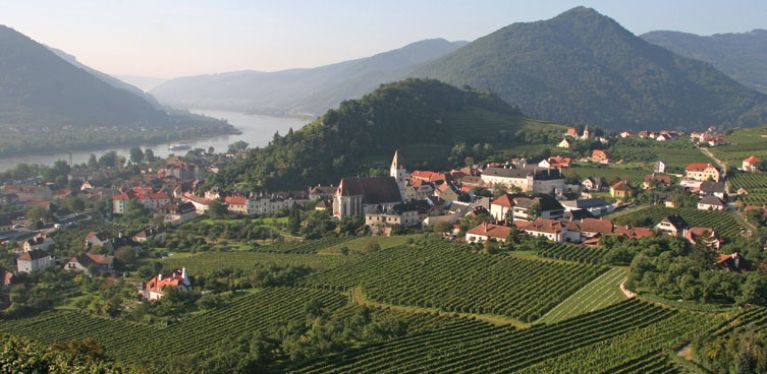
Travel tip: through the UNESCO Heritage Site Wachau
The prettiest section of this leg is the 75-kilometre stretch on the B3 and B33 from Grein to Krems. If you have chosen the fastest and most direct route, we recommend you exit the A1 autobahn no later than Amstetten. Your reward is a drive through a unique landscape with a rich cultural heritage: to your right the wide and winding Danube; to your left, rising almost directly from the river, the vineyards of the Wachau, a UNESCO Heritage Site.You will pass through towns such as Spitz an der Donau and Dürnstein, home to some of the country’s top vintners; conditions on the steep terraces of the Wachau region are ideal, both for delicate as well as more complex wines. Franz Hirtzberger winery or Weingut Knoll are two excellent examples.
Good soil, good start: The wine town of Langenlois and the Loisium
Just after Krems follow the signs and turn left towards Langenlois. It’s about a 15-minute drive to Austria’s biggest wine producing town with 2,000 hectares under cultivation. You won’t regret taking this small detour through Langenlois with its outstanding vineyards and historic Kornplatz square which is lined with traditional wineries and grandiose houses; be sure to visit the modern museum and wine centre Loisium Wine World.Explore the 900 year-old labyrinth of cellars with 19 information stations then head over to the amazing laser show in the basilica whose modern design was the work of architect Steven Holl. After your tour, enjoy a visit to the Loisium shop with regional delicacies and the obligatory wine section with over 220 wines from the area, which you can taste and buy at ex-vineyard prices.

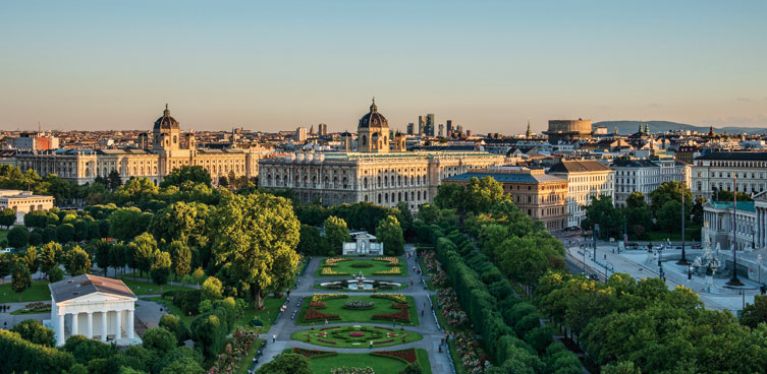
The capital of joie de vivre: Vienna
The Danube without Vienna – unthinkable. The Habsburgs without Vienna – totally unthinkable. Schloß Schönbrunn is both a World Heritage Site and the symbol of the Habsburg dynasty of Kings and Emperors, so what better way to end this fascinating trip along the Route of Kings and Emperors.This sumptuous baroque jewel of palace and gardens has remained largely unchanged since its former days of glory and grandeur. Staying on the theme of Kings and Emperors, a visit to the Hofburg and the Hofmobiliendepot [royal furniture storage] is an absolute must. After feasting on so much cultural heritage, it’s time for more worldly pleasures in Vienna’s vibrant culinary centre, the Naschmarkt. Explore and enjoy the extensive variety of food and drinks which is unsurpassed anywhere else in Austria.
Recommendations for hungry and weary travellers:
Image credits in chronological order: (1) WGD Tourismus GmbH/Weissenbrunner; (2) Tourismusverband Linz; (3) Mostviertel Tourismus; (4) ARGE Straße der Kaiser und Könige; (5) Niederösterreich Tourismus/Othmar Bramberger; (6) Loisium, Robert Herbst; (7) WienTourismus, Christian Stemper
- Stiftskeller und Stiftsschenke Heilig Geist, Passau (traditional restaurant)
- Hotel Goldenes Kreuz, Grein
- Vinothek Winzer Krems, Krems (wine bar)
- Café Sperl, Vienna
- Restaurant Essig’s, Linz
- Hofmeisterei Hirtzberger, Wösendorf (restaurant)
- Loisium Spa & Weinerlebniswelt, Langenlois
- Restaurant Ofenloch, Vienna
Image credits in chronological order: (1) WGD Tourismus GmbH/Weissenbrunner; (2) Tourismusverband Linz; (3) Mostviertel Tourismus; (4) ARGE Straße der Kaiser und Könige; (5) Niederösterreich Tourismus/Othmar Bramberger; (6) Loisium, Robert Herbst; (7) WienTourismus, Christian Stemper